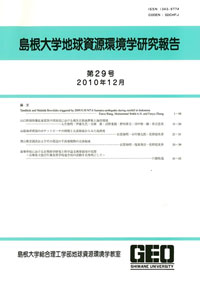島根大学総合理工学部地球資源環境学教室
ISSN:1343-9774

number of downloads : ?
Use this link to cite this item : https://ir.lib.shimane-u.ac.jp/6090
Geoscience reports of Shimane University 20
2001-12-28 発行
諌早湾閉切り前後における底質の元素組成の変化
Changes of geochemical compositions of bottom sediments related to the sea dyke in lsahaya Bay of Ariake Sea,Japan
File
Description
Isahaya Bay was the largest intertidal mud flat in Japan.In April 1997,the bay was closed by a dyke for reclamation and was isolated from the Ahake Sea.This resulted in the formation of stagnant and deteriorated condition in the bay,especially in the inner side of the dyke.Core samples from both the inner and outer sides of the dyke confirm the abrupt changes in lithology,biota,and various geochemical parameters.Mud samples in the upper parts which were deposited after the closure show higher concentrations of Pb,Zn,Cu,P_2O_5,TOC and TN,suggesting element accumulation in sediments under reducing conditions.This enrichment may be related to the disappearance of an ecosystem which previously effected bioremediation.
Other Article
PP. 1 - 12
PP. 25 - 40
PP. 83 - 86
PP. 109 - 115
PP. 125 - 131
PP. 143 - 152
PP. 153 - 161
PP. 189 - 194
PP. 217 - 226
